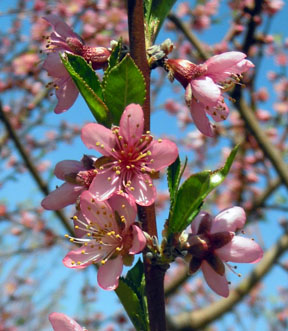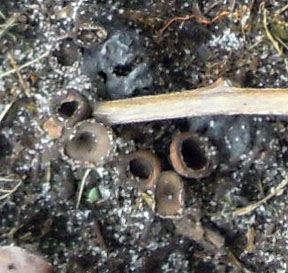Blossom time in Southwest Michigan
A warm week causes a rapid green up as plants move quickly. Many tree fruits are in bloom.
The last week was relatively warm and dry. Highs rose into the 70s with lows in the 50s. A few rain showers caused a disease infection for apple scab and mummy berry on Saturday (May 7) in the south. This week will be warmer with highs rising to 80° away from the Lake. Lows will rise from the 50s to the 60s. Thunderstorms are possible. Soils are drying rapidly, so field work and planting are underway. Soil temperatures are in 50s. We are catching up with growing degree days, but are still about a week behind normal. We should catch up a lot this week. We will be picking up about 20 GDDbase 42 a day and about 12 base 50. Check for the closest weather station at MSU’s Enviro-weather.
Southwest Michigan growing degree day totals from March 1 through May 8, 2011.
| Location | GDD 42 | GDD 45 | GDD 50 |
| SWMREC | 295 | 211 | 114 |
| Trevor Nichols | 243 | 173 | 92 |

Peach bloom.
Tree fruit
Warmer weather has increased insect activity. Redbanded leafroller and Oriental fruit moth are being caught. With stone fruit blooming, a warm shower could cause blossom brown rot. Temperatures above 70 are optimal for the disease. Only about five hours of wetness are required for an infection at 77°F. Growers will need to protect against brown rot.
Apricots are in the shuck.
Peaches are at full bloom. Leaves are about an inch long and unfolding. Crop potential is still excellent. Growers need to protect against brown rot. Copper programs to suppress bacterial spot on disease prone sites and varieties are continuing in some area orchards. Oriental fruit moth pheromone dispensers should be out in peach orchard to control the first generation. In many orchards, Oriental fruit moth was biofixed last week.
Sweet cherry full bloom has past and petal fall has begun. Open stone fruit blossoms are susceptible to brown rot infection in warmer rains. Leaves have begun to unfold and are susceptible to cherry leaf spot.
Tart cherries are close to full bloom. Leaves are beginning to unfold on trees with a light bloom and growers will need to protect against cherry leaf spot soon.
In plums, Japanese plum bloom is finished and most of the flowers have fallen off indicating a poor fruit set. European plums are blooming. Black knot control should start before bloom, during early shoot growth.
Apples are at pink. ‘Zestar’ is at full bloom and Idared is at first bloom. As bloom approaches, growers should plan on fire blight controls. There is a Section 18 for the use of Kasumin for fire blight in counties where streptomycin resistant strains have been documented. The fire blight tool on Enviro-weather can be used to forecast the risk of blossom infection.
Growers have been spraying for apple scab. Symptoms of apple scab have not yet appeared but are expected from the April 15 infection period. Lesions from the late April infection periods (22, 25, and 27) should appear this week. Applescab spore production usually peaks at bloom time so protectant sprays are very important during pink. Growers can use the scab infection tool on the Enviro-weather web site to track infection periods and when symptoms will become visible. Pink is the best time to target rosy aphids in varieties such as Golden Delicious, which are prone to this pest.
Pears are blooming. Pears are also susceptible to fire blight and pear scab which is similar to apple scab. Pear growers should use the apple tools for these diseases to help plan their control strategies. Pear psylla are out and active during the sunny warm periods.
Small fruit
Grape buds burst but leaves have yet to unfold. That will happen quickly with the warm temperatures forecast. Cutworms and grape flea beetle are not a major problem after the buds have burst. Disease control sprays should begin as leaves unfold. It is important to get fungicide applications on early to control phomopsis infections at bud break.
Blueberry fields are drying out, but water is still standing in many fields. Flower buds have burst and early varieties are showing early pink bud. Leaf buds are about a half inch long and leaves are unfolding. The last mummyberry infection period was Saturday evening (May 7). Mummy berry trumpets are drying out but some are still capable of releasing spores. Few new trumpets are emerging. Growers still need to protect against mummy berry shoot blight. Winter injury is becoming more visible as tip die-back, empty flower buds that open prematurely, or other flowers buds that stop growing after the initial bud swell. With the warm temperature forecast for this week, we may see bloom in early varieties by the weekend. Obliquebanded leafroller feeding has been reported in flower clusters.

Dried out mummy berry trumpets near South Haven.
Strawberries flower trusses have emerged from the crown. Once the flowers emerge, the critical temperature for freeze damage is 20°F.
Brambles winter injury is visible in many sites, especially in blackberries. Leaves are unfolding. New primocanes in fall bearing raspberries as well as in winter injured fields are emerging and generally only a few inches high.
Cranberry fields are starting to green up near the drainage ditches. Upright flower buds are swollen at cabbage head.



 Print
Print Email
Email


